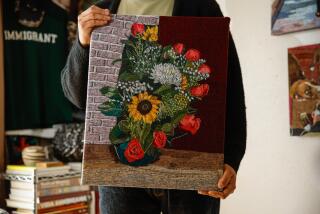Turf Trends on the Playing Field
David R. Mellor has designs on making grass a fashion statement. The new director of grounds for the Boston Red Sox made a big impression in May when he put the Red Sox logo in the infield and a “100” in the outfield to celebrate the team’s centennial.
Mellor sharpened his sports-turf style while working as an assistant groundskeeper for the Milwaukee Brewers in the 1990s. Since he began mowing stripes, plaids, waves, starbursts and abstract designs into the grass at Milwaukee County Stadium, more and more patterns have sprouted up on other fields around the country.
Mellor’s “Picture Perfect: Mowing Techniques for Lawns, Landscapes and Sports” (Ann Arbor Press, $34.95) hit the shelves in June. His patterns also have been included in the international touring exhibition “The American Lawn: Surface of Everyday Life.”
The secret to his mowing success is rollers, which any golf course superintendent will tell you are nothing new. “The first mower, developed in 1830s Victorian times, always left stripes when it cut grass,” Mellor says from the Fenway Park office he moved into in January. Instead of wheels, the mowers were supported by rollers behind the reel. The roller bent the grass, which gave the lawn a striped look; grass cut with the rollers going away from you looks lighter, while grass cut with the rollers coming toward you looks darker.
His inspiration comes from a variety of sources. Sometimes, his daughters Catherine, 11, and Tori, 7, draw a design with their crayons for dad to try out. “Or if I see a carpet or clothing pattern I like or something on another field, I’ll borrow ideas,” Mellor says.
Depending on the design’s complexity, he may have his grounds crew cut a pattern on the fly. Or Mellor will stake out where he wants stripes cut or sketch a tartan on a piece of paper. For the most elaborate designs, he’ll use a computer-assisted design or PowerPoint program on his computer. With practice, cutting a fancy pattern might add only 45 minutes to the usual mowing time, he says.
But there was no time to practice his first design. Mellor had to turn a water-soaked nightmare into a field of dreams. Mother Nature, Paul McCartney and the Yankees are to be thanked--or blamed--for this phenomenon. The former Beatle was to play at Milwaukee County Stadium in 1993. During the setup (which included laying 2,000 sheets of plywood in the outfield), the concert itself and the breakdown of the stage, it rained. And that left the outfield mucky, just in time for a game the next day against the Yankees.
“We made it safe and playable, but aesthetically ... we had to draw people’s attention away from the damage,” Mellor says.
So the grounds crew cut diamond and striped patterns in the outfield and infield. Phil Rizzuto and the other announcers, Mellor remembers, didn’t say much about the damaged outfield, “but they kept commenting on how nice the mowing looked.”
“We started getting calls over the next couple of days from homeowners and colleagues,” Mellor says. “They wanted to know how we did it.”
Now all sizes and stripes of teams around the country have begun cutting complex patterns into their fields.
More to Read
Go beyond the scoreboard
Get the latest on L.A.'s teams in the daily Sports Report newsletter.
You may occasionally receive promotional content from the Los Angeles Times.










